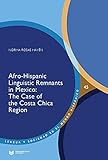Afro-Hispanic Linguistic Remnants in Mexico : The Case of the Costa Chica Region / Norma Rosas Mayén.
Material type: TextSeries: Lengua y Sociedad en el Mundo Hispánico ; 45Publisher: Frankfurt am Main : Vervuert Verlagsgesellschaft, [2021]Copyright date: ©2021Description: 1 online resource (189 p.)Content type:
TextSeries: Lengua y Sociedad en el Mundo Hispánico ; 45Publisher: Frankfurt am Main : Vervuert Verlagsgesellschaft, [2021]Copyright date: ©2021Description: 1 online resource (189 p.)Content type: - 9788491921707
- 9783968690940
- 417.22 23/eng/20230216
- online - DeGruyter
| Item type | Current library | Call number | URL | Status | Notes | Barcode | |
|---|---|---|---|---|---|---|---|
 eBook
eBook
|
Biblioteca "Angelicum" Pont. Univ. S.Tommaso d'Aquino Nuvola online | online - DeGruyter (Browse shelf(Opens below)) | Online access | Not for loan (Accesso limitato) | Accesso per gli utenti autorizzati / Access for authorized users | (dgr)9783968690940 |
Frontmatter -- Acknowledgments -- Contents -- Chapter 1. Introduction -- Chapter 2. Creole Genesis and the Rhizomatic Linguistic Model -- Chapter 3. Methodological And Historical Remarks -- Chapter 4. Phonological Characteristics of Costeño Spanish -- Chapter 5. Morphological and Syntactic Characteristics of Costeño Spanish -- Chapter 6. Lexical Characteristics of Costeño Spanish -- Chapter 7. Conclusions -- References -- Appendix. Photo Gallery
restricted access online access with authorization star
http://purl.org/coar/access_right/c_16ec
In the last decades, the study of Afro-Spanish varieties that developed during the Colonial period in the Americas has seduced many scholars. The analysis of these Afro-Hispanic speech patterns is crucial to determine their creolized or non-creolized status, as well as to understand the scarcity of the Spanish-based creoles in the Americas. The present study contributes to this linguistic field by analyzing the current speech of the Afro-Mexicans of the Costa Chica region, one of the largest Afro-Mexican enclaves, while proposing a Rhizomatic Linguistic Model to interpret data derived from contact situations. This investigation not only accounts for the Afro-Hispanic linguistic remnants of this Spanish variety, but also examines the current linguistic characteristics and sociolinguistic status of this speech area on the brink of extinction. In addition, this book advocates on behalf of those Costa Chica Afro-Mexican communities that have been stigmatized and customarily ignored in Mexico’s nation-state politics.
Mode of access: Internet via World Wide Web.
In English.
Description based on online resource; title from PDF title page (publisher's Web site, viewed 25. Jun 2024)


